Key takeaways
- Handmade paper crafts offer a deep sense of personal connection and satisfaction through the creative process.
- Understanding the right materials, like adhesives and paper types, is crucial for successful decoupage projects.
- Patience is essential; allowing sufficient time for each layer to dry can significantly enhance the final outcome.
- Exploring different techniques and materials can open up new creative possibilities and improve overall skills.

Introduction to handmade paper crafts
Handmade paper crafts have a unique charm that machine-made products just can’t match. There’s something deeply satisfying about creating something from scratch, feeling the texture of the paper, and watching your ideas come to life layer by layer. Have you ever noticed how a simple sheet of paper can transform into a beautiful keepsake or decoration with just a bit of creativity?
For me, the appeal lies in the process itself—the way folding, cutting, and decorating paper can calm my mind and spark new inspiration. Each piece tells a story, reflecting not only skill but also the patience and care poured into it. Doesn’t that make handmade paper crafts feel more personal and meaningful?
I’ve found that working with handmade paper invites experimentation, whether it’s trying different textures, colors, or techniques. It encourages a hands-on connection that you just don’t get from digital or mass-produced crafts. Maybe that’s why so many people, like me, find joy in this timeless art form.
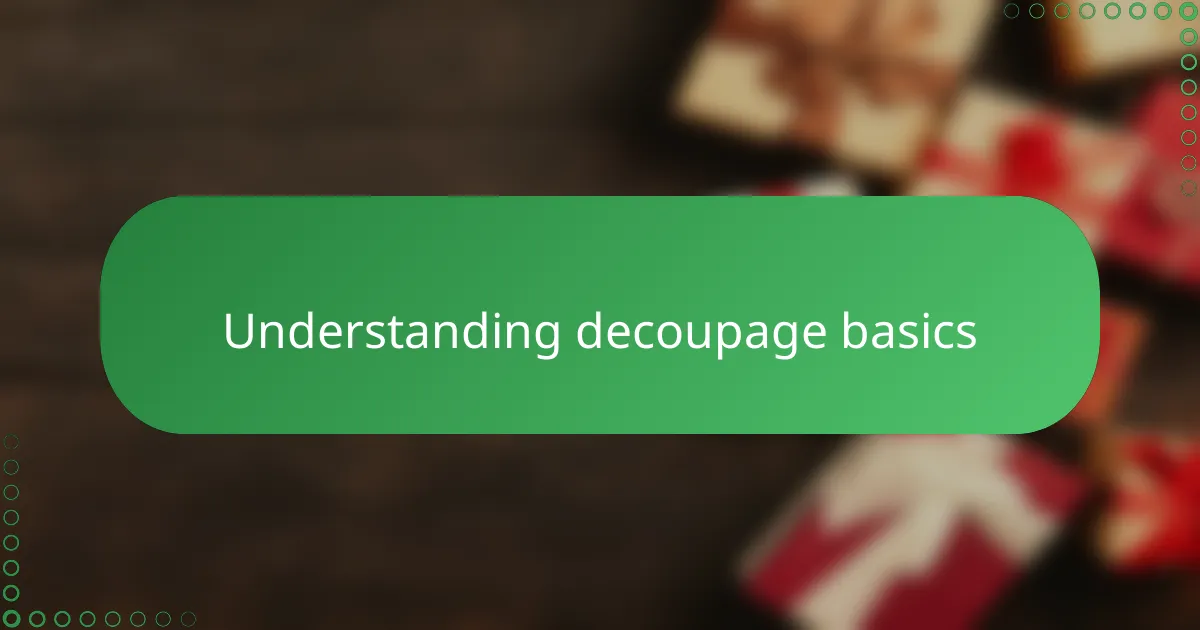
Understanding decoupage basics
Decoupage, at its heart, is all about layering paper cutouts onto surfaces to create something visually rich and textured. When I first encountered it, I was surprised by how simple the basic steps seemed—just glue, paper, and patience—but also how much room there is for creativity within those boundaries. Have you ever thought about how adding just one layer can completely change the mood of a piece?
One thing I quickly realized is that understanding the right materials is key. Not every paper or adhesive works the same way, and learning which combinations hold up best was a genuine game-changer for me. It made the difference between a project that lasted and one that didn’t, and that sense of discovering what works deepened my appreciation for the craft.
What really stayed with me is how decoupage is as much about intention as technique. You’re not just sticking pieces down—you’re building a narrative, choosing images and textures that speak to you. That personal connection is what makes each finished piece feel unique and special, something I hadn’t anticipated when I first started watching tutorials.
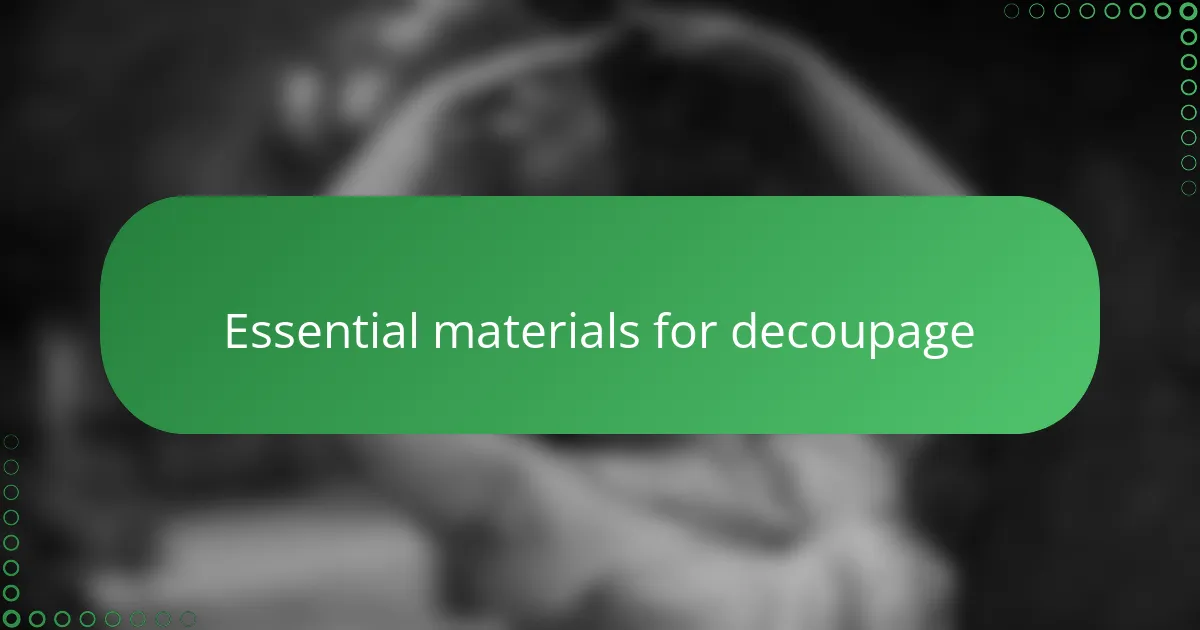
Essential materials for decoupage
When I first dove into decoupage, I quickly learned that having the right materials made all the difference. I started with basic glue, but soon realized that using a special decoupage medium not only helped the paper stick better but also created a smooth, protective finish. Have you ever been frustrated by wrinkled or bubbled paper? That’s usually a sign that the adhesive or paper choice wasn’t quite right.
Selecting the paper itself was another eye-opener. At first, I grabbed any scrap I had lying around, only to find some papers tore easily or didn’t lay flat. I discovered that lightweight, thin papers like tissue paper or special decoupage napkins work best—they blend seamlessly when glued and avoid bulkiness. This subtle distinction really elevated my projects and gave them a polished feel.
Of course, you’ll also need tools like soft brushes for applying glue gently and a craft knife for precise cuts. I remember fumbling with scissors and ending up with uneven edges until I treated myself to a small cutting mat and blade—it was a game-changer. Have you tried this? Even small adjustments in your tools can make the whole process smoother and more enjoyable.
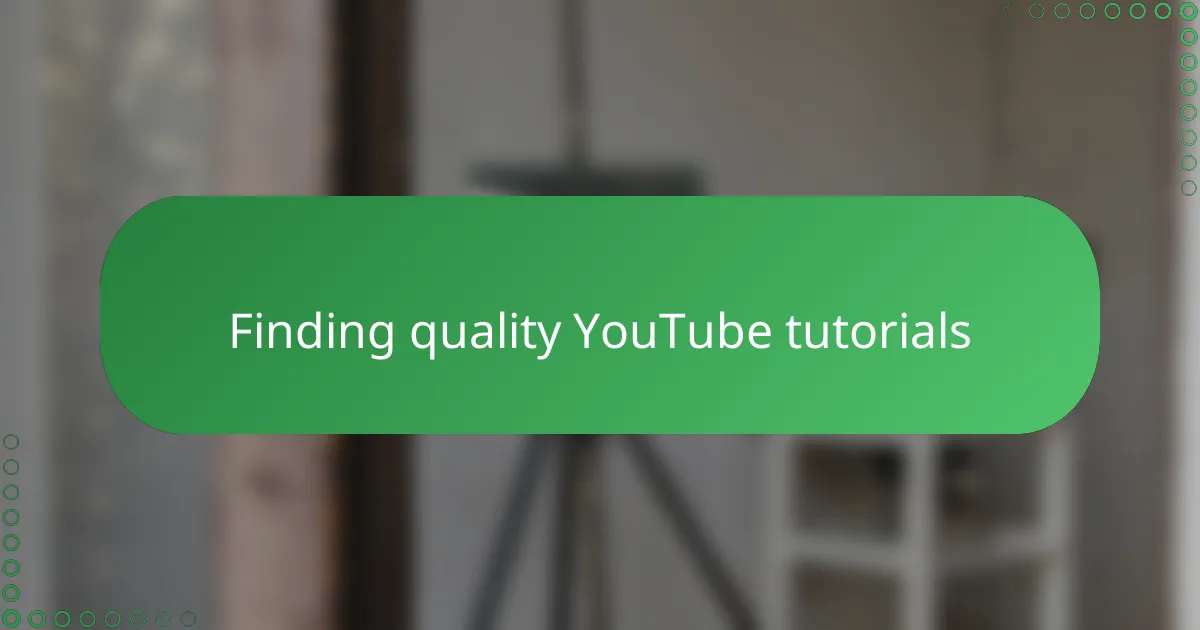
Finding quality YouTube tutorials
Finding quality tutorials on YouTube felt like searching for a needle in a haystack at first. I found myself clicking on videos with poor lighting or unclear instructions, which only left me more confused. Have you ever felt that frustration when a creator rushes through steps or assumes you already know the basics? That definitely slowed down my learning.
What helped me was looking for creators who took their time explaining materials and techniques, showing close-ups, and sharing mistakes along the way. I remember settling on a few channels that felt like having a patient friend guiding me through each phase. It made such a difference knowing I wasn’t alone in figuring things out.
I also started paying attention to comments and ratings to gauge which tutorials others found helpful. Sometimes, a single detailed video with thoughtful tips beat dozens of shorter clips. Don’t underestimate the value of consistency—following one creator’s style helped me build skills step-by-step instead of jumping around aimlessly.
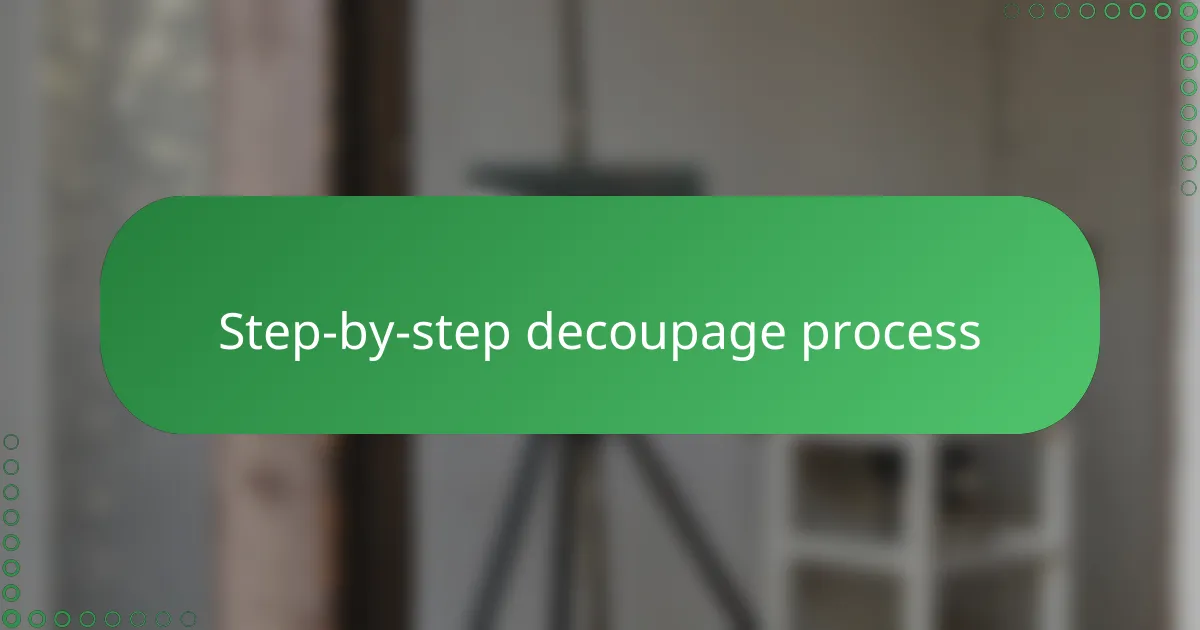
Step-by-step decoupage process
The step-by-step decoupage process really became clear to me once I broke it down into simple stages. First, I carefully cut out the paper images, making sure the edges were smooth because jagged cuts can distract from the final look. Have you ever noticed how much neater a project feels when the pieces fit perfectly from the start?
Next came the glue application, which I quickly learned is all about patience. I applied a thin, even layer of decoupage medium both under and over the paper cutouts, gently smoothing out bubbles as I went. It took a few tries to master that delicate touch—too much glue and the paper wrinkles, too little and it doesn’t stick properly.
Finally, sealing the piece with additional coats of the medium gave it that lovely, polished finish that made me proud of my work. Each layer had to dry fully before the next, teaching me the value of slowing down and savoring the process. Isn’t it amazing how such small, mindful steps unite to transform simple paper into a lasting piece of art?
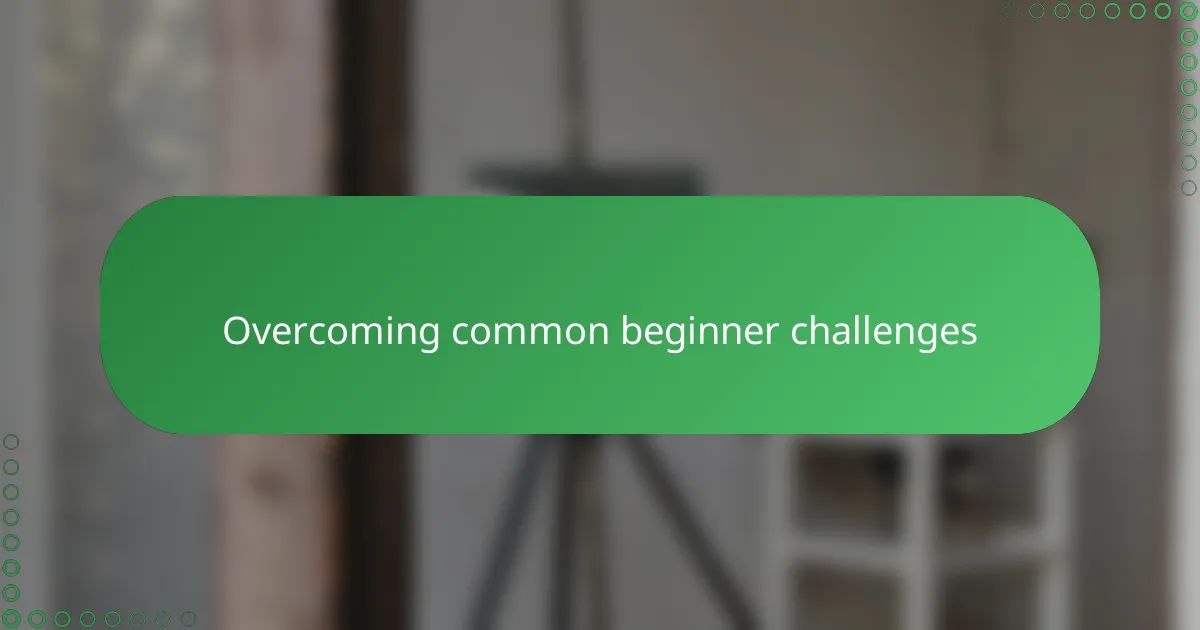
Overcoming common beginner challenges
One of the biggest challenges I faced as a beginner was controlling those pesky wrinkles and bubbles when applying glue. It felt so frustrating the first several times—no matter how carefully I tried, imperfections still showed up. But over time, I realized that patience and a gentle hand were key; slowing down and smoothing each layer with a soft brush made a noticeable difference.
Another common hurdle was choosing the right paper. I remember eagerly grabbing colorful scraps only to have them tear or warp under the glue. Have you ever had that sinking feeling when your project starts looking messy despite your best efforts? Learning to pick thin, flexible papers transformed the whole experience for me and boosted my confidence.
Lastly, I struggled to avoid rushing through the drying phases. I used to want to finish everything in one sitting, but that just led to smudges and uneven finishes. Waiting between coats felt tedious at first, but now I appreciate how that pause lets the layers set properly, making the final piece much more polished. Isn’t it fascinating how patience can turn frustration into satisfaction?
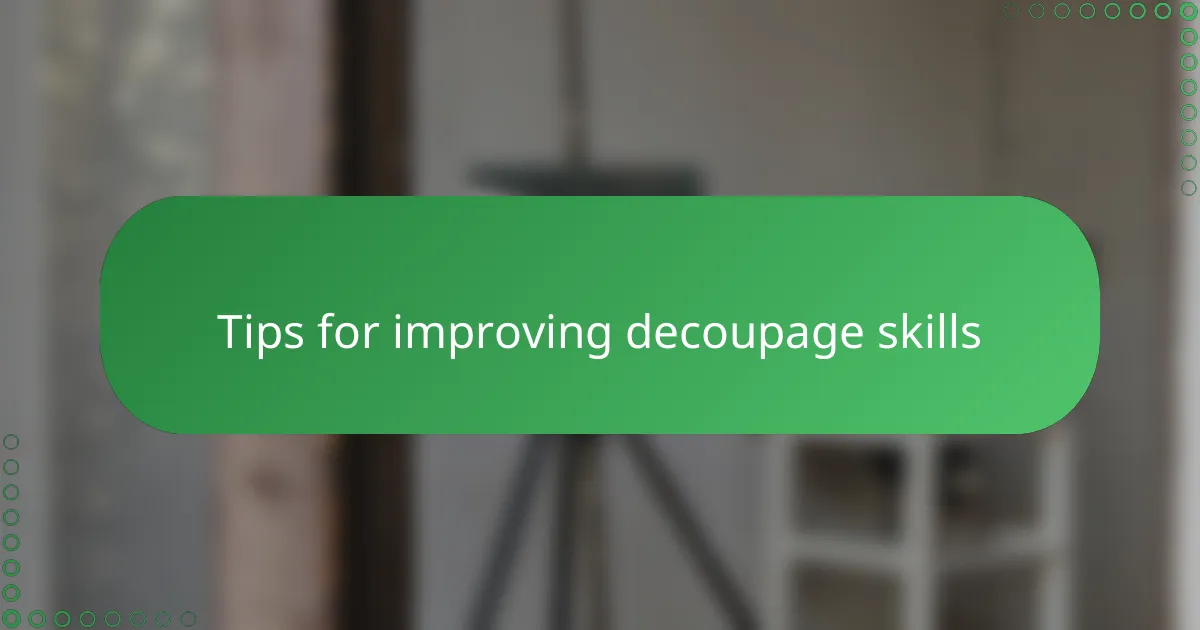
Tips for improving decoupage skills
What really helped me level up my decoupage skills was practicing the art of patience—taking my time with each layer instead of rushing. Have you noticed how a slow, steady hand prevents wrinkles and bubbles much better than a hurried one? It felt frustrating at first, but embracing that calm pace transformed my results and made the process more meditative.
I also found that experimenting with different papers and glues opened up new possibilities. Sometimes I surprised myself by combining delicate tissue paper with a matte finish medium, creating textures I hadn’t imagined. Do you ever get that thrill when a simple switch in materials suddenly makes your piece look more professional? That sense of discovery kept me motivated to keep trying.
Lastly, watching replayed tutorial segments and pausing frequently became my secret weapon. It was tempting to watch videos at double speed, but slowing down helped me catch subtle techniques, like the best way to smooth edges or apply glue sparingly. When was the last time you gave yourself permission to learn at your own rhythm? For me, that gentle approach made all the difference.
